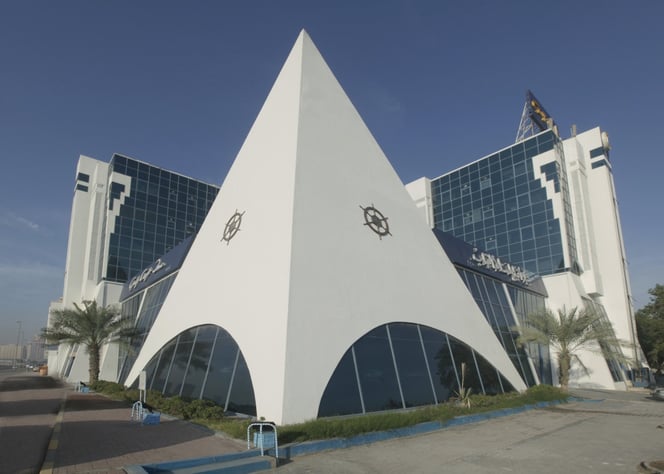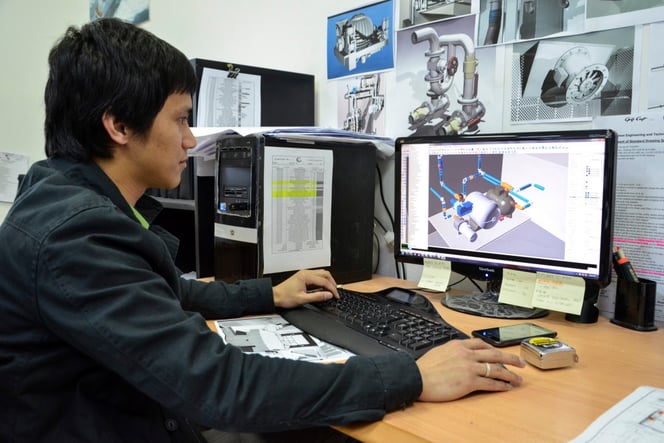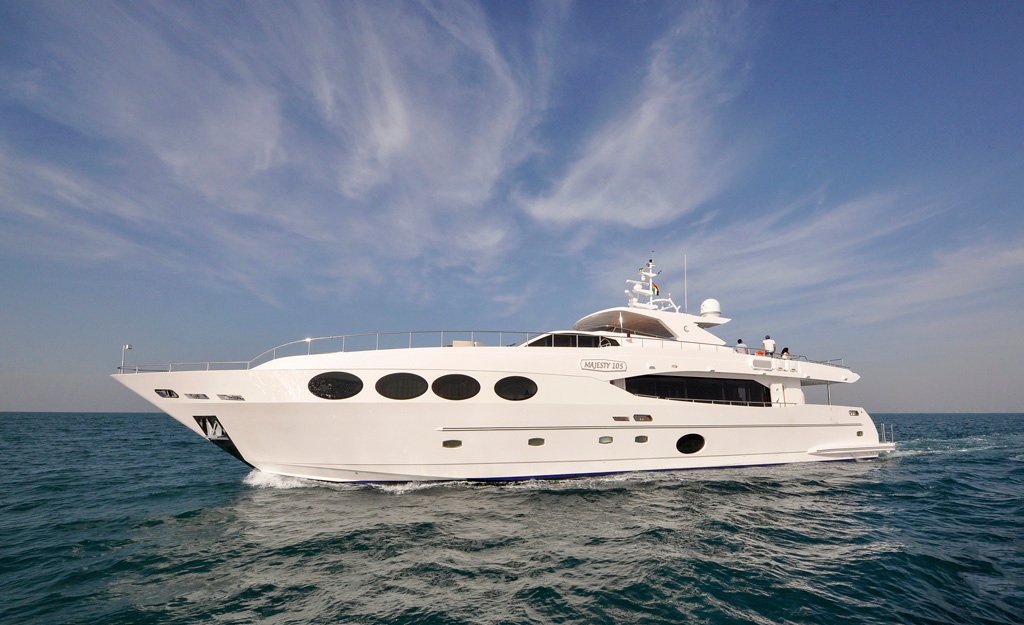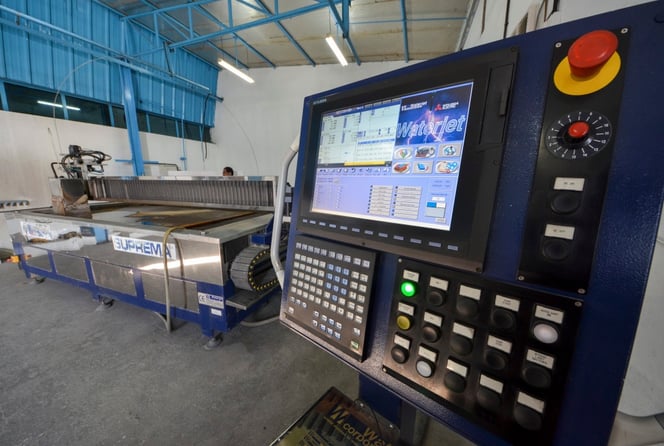Heavy investment in new equipment, hands-on local knowledge and an incentivised staff is all providing Ajman-based Gulf Craft with a strong order book.
A lot can change in two years, especially in the UAE. Back in May 2010, Gulf Craft invited us to view its modern facility at the port of Umm Al Quwain, about a 40 minute drive from Dubai International airport. At the time of our visit, the yard had two of its latest Majesty 125 (38 m) yachts in build, and while orders for the mid-range models, 14 m to 30 m (45 ft- 65 ft), had slowed in the downturn, business was still good.
When we went back in December 2012, and with the world's economy still in recession, we found the yard flourishing. The main construction halls were packed with no less than four new builds of over 30 m (98 ft), and explorer yacht hulls were under construction in the adjacent hall. Despite being geared for semi-custom production, everything was being built to order.
The largest luxury yachts being built here are all in the Majesty Yachts range, currently offering five models from 31 m to 41 m (101 ft-135 ft) but with a very high level of customization.
Superyachts account for over 30 percent of Gulf Craft's turnover, as yet it is one of the few superyacht yards worldwide that builds a huge portfolio of smaller craft as well, including patrol craft, rescue vessels and fishing boats. Spread over four production facilities, the yard has an output capacity of 500 vessels a year, around 70 per cent of which are exported to over 40 countries.
This line-up could soon be extended, as in the pre-production workshops the moulds for a secretive new project were under construction. Meanwhile, everywhere we looked we saw new, state-of-the-art equipment such as computer-controlled CNC machines and high-pressure water cutters.
The 1,500 staff, the majority of whom are from the Indian subcontinent, seemed even more driven than usual - the result of a clever incentive scheme that rewards not only quality craftsmanship and hard work, but also the submission of good ideas. Meanwhile, the management team has been tapping into talent from overseas, bringing in a wealth of experience from some well-known western yards. To say there was a buzz about the place would be an understatement.
Steady rise
In 1982, Mohammed Hussein Alshaali, the current chairman, founded Gulf Craft with his brothers Abdullah and Jamal. A fourth partner was family friend Dr Mohammed Hamdan. They set up a modest factory in Ajman, and with just 19,620 m2 of covered floor space, began producing a series of small open fishing boats for the local market. After the fledgling company diversified into leisure craft - all designed for hot climates and open sea - and moulded on site in GRP, the rapid rise of wealth in the region meant that sales took off.
In 1992, Gulf Craft produced its first complex flybridge motoryacht, the Adora 53, which quickly became a best seller. In 1997, the first of the Majesty Yachts range appeared in the form of the Majesty 85. With demand outstripping supply, the company quickly outgrew its Ajman facility but retained it as the company HQ. The refurbished building is now being surrounded by new high-rise apartments, a testament to Dubai's resurgence as a property hot spot, and features a large showroom alongside the production facility for smaller craft.
 Gulf Craft's headquarters are in a modern building in Ajman at the site of the original factory , but superyacht production takes place at nearby Umm Al Quwain
Gulf Craft's headquarters are in a modern building in Ajman at the site of the original factory , but superyacht production takes place at nearby Umm Al Quwain
In 2000, the directors commissioned a new factory at the nearby port of Umm Al Quwain for the mid to top range yachts. This quayside site immediately provided over 40,000 m2 of space, 23 ,000 m2 of it under cover, with direct access to the sea via a 150 tonne travel lift. It was at this time that the yard launched its first superyacht of over 30 m (98 ft), the Millennium 118, debuting in 2001 and proving just what could be achieved in the Middle East.
Keen to build on the Millennium's success, and so become a serious contender in the
global superyacht market, Gulf Craft started work on its next flagship, the Majesty 121, followed shortly after by the Majesty 125. SB saw the first one being built during our original tour in 2010, and noted the high level of craftsmanship being applied to the sleek, 24-knot GRP hull. The following year we were invited aboard the finished yacht at her charter base at Bandol in the South of France. A key selling point of the design, which had delighted her crew of six, is that the deck layout allows them to move freely around the vessel without impeding the guests.
Meanwhile, rebranding had also taken place in the rest of the fleet, with the Oryx Sport Cruiser range introduced in 2006 to fill the gap between large yachts and small runabouts. The Silvercraft range was established in 2008 to represent Gulf Craft's original pedigree, the smaller family dayboats and sports fishing craft.
Fortunately, COO Erwin Bamps had anticipated the effects of the global economic crisis, so had been able to formulate a strategy to cope. He had predicted the cooling of the mid range market, a key part of Gulf Craft's output, but also realised there would be greater interest in custom builds at the top end. "There was a lot of global over capacity in the 45 ft to 80 ft sectors," he explained. "This was the area that was hardest hit. However, those who still wanted a brand new superyacht would be asking for a high level of customization, but at a very favorable price."
While still courting buyers, mainly in the traditional markets of Europe and the US, and particularly Australia, Bamps decided to also explore the new markets of India and China, to secure new build orders. In 2011 , and having identified a local trend of 'social superyachting', Gulf Craft launched its new Gulf Explorer 95 at the Dubai boat show. "This yacht was a departure from the more traditional yachts," Bamps says. "The emphasis is more on the accommodation and comfort rather than a stylish exterior. Its purpose is to be a luxurious apartment by the sea, where people can relax and entertain, so it has a great deal of internal volume with plenty of panoramic sea views."
During 2012, the company launched the first of its 135 models, building on the success of the 125, and we understand that a striking new model is in the pipeline for launch at the forthcoming Dubai boat show.
Chairman Alshaali has always seen manufacturing as the long-term future of the UAE when oil production declines, so was fully behind Bamps' plans to upgrade the Umm Al Quwain facility with better machinery and advanced working practices, with the introduction of the Japanese kanban system (a system to control the logistical chain from a production point of view) and Six Sigma continuous improvement process tools.
Gulf Craft's philosophy is to produce as much of the yacht as possible in-house, and so offer customers a highly flexible fit-out. This has led to some vastly different sister ships, with one interior looking like a chic Parisian hotel, while another resembles the inside of a space station. Essentially, whatever the client wants, they can have - providing the yacht can still conform to class requirements.
Bamps tackled the refurbishment and upgrade of the facility in three phases. Firstly, he greatly increased the in-house design team, and bought in the latest 3D modeling software. This allowed the designers to work more closely with clients to interpret their wishes. He also recruited additional project managers from Europe with long track records in new builds. The next phase was to increase both capacity and efficiency by investing in the latest machinery.
 Gulf Craft has doubled the size of its drawing office and provided the latest Rhino 3D modelling software.
Gulf Craft has doubled the size of its drawing office and provided the latest Rhino 3D modelling software.
"Many yards use subcontractors, but I believe this can often be a disadvantage," Bamps says. "Apart from being totally dependant on them, and risking production hold ups, you also have to pay their margins, so the price of the yacht increases. We have always believed it is more cost effective to create your own departments, and equip them to be able to produce the highest quality components on both a production and custom basis."
The final - and perhaps most important - phase of the upgrade was with the staff. The region is almost wholly dependant on labour from the Philippines and India, the latter itself a booming manufacturing and service economy, and Gulf Craft has tapped in to the pool of skilled labour available in the UAE. The craftsmen are therefore mostly Indian, with a few other nationalities
represented at the administrative level.
The salaries of the shop floor workers might be relatively low by Western standards, which helps to create a highly competitive product, but in real terms they are well rewarded, with many supporting extended families back home. They are also housed by the company, and as there are no unions in the UAE, and multi-skilling is encouraged, they can be moved around to where they are needed. Buses are laid on to transport workers between the various facilities, with overtime eagerly accepted.
Bamps has also bought in a tiered set of bonus payments, with quality and progress actively monitored and shown on graphics attached to bulletin boards in each department. If targets are hit, each team gets a worthwhile boost to their pay. At the end of one shift we saw the workers excitedly gathered around a board to see who had been named 'team of the week.' The pleasant working environment combined with motivational management, encouragement to advance, and good rates of pay has meant strong staff loyalty, with many craftsmen developing long-term careers at the yard.
Building for the future
Touring the outlying workshops in the benevolent December sunshine, we noticed how the stainless steel shop had been greatly upgraded, with more staff, more equipment, and a nearby waterjet cutter that could slice intricate shapes from solid stainless steel plate with minimal waste.
Gulf Craft prides itself on the standard of its metalwork, producing everything from the deck hardware to articulated pantograph doors. With skilled man-hours relatively cheap, labour-intensive one-off projects can become cost effective. The waterjet cutter has also been put to good use creating ornate marble and stainless steel motifs for exterior badges and interior decor. Moving in to the main production hall, where the rearmost part has been divided into three storeys of joinery shops, we saw that the upgrades had continued. This area creates the furniture for a wide range of vessels, some on a production basis, but also for the bespoke fit-outs for the Majesty Yachts range.
New CNC machines were in operation, which interpret the plans fed to it directly from the design
department. Gulf Craft also has a marble cutting facility nearby, working closely with the joinery shop to create the lightweight but solid-feel work surfaces and decorative floors. In the main shed itself, three hulls were sitting side by side, accessed from a mezzanine. A row of offices for the project managers was located on the third floor and looked directly down on the new builds.
Following their view, from left to right we saw a 135 in the early stages of build, another 135
that was still in its mould, and a 125 that was halfway through production. Nearest the door,
and closest to completion, was a further 135. On a temporary platform built at the stern
of one of the medium size yachts was an example of the new kanban system in operation. Many man-hours can be lost when workers have to walk backwards and forwards to the stores. Now, each boat has it's own on-site storeroom, which is replenished on a regular basis so consumables and tools are directly to hand. The project offices for the 95 are also right alongside, so the project
managers can keep a close eye on progress.
Refitting and upgrading
Out in the yard itself, Gulf Craft had a number of refit projects underway. Owners like to bring their boats back to the factory for upgrades and routine maintenance, and this helps to keep a steady flow of work throughout the year. The ideas and feedback that owners invariably bring with them are also welcome. A number of yachts from across the range were docked to the company's long pontoon, including a Majesty 105, a strikingly unusual yacht with a sloping foredeck, signature oval windows, and with the emphasis very much on outdoor socialising.
In every department, especially in the joinery shops, we noticed a very high standard of tidiness. Under the new incentive scheme, and in accordance with the yard's programme to enhance safety and efficiency, cleanliness and orderliness are two of the categories that count towards a bonus, mainly because they help to improve quality while also saving time.
As we left the yard to a security guard snapping us a crisp salute, we came away with the impression that this company knew exactly what the future held. It had applied the best working practices, invested in the latest machinery, and introduced a new range of models based on decades of
customer feedback. With the production halls full of new builds, a tranche of newequipment, and a cheerful, incentivised workforce, it seems that as far as Gulf Craft is concerned the recession is over.
But with a management that never rests it is always looking to make each yacht better than the last, "In today's market, people want to go beyond the brochure," Bamps explained. "At Gulf Craft, we're happy and fully able to oblige them.''
Read the complete article by Mr. Jake Kavanagh in the Superyacht Business magazine, February 2013, Issue 32:
[gview file="http://blog.gulfcraftinc.com/wp-content/uploads/2014/08/Article-Superyacht-Business-Issue-32-February-2013.pdf"]



